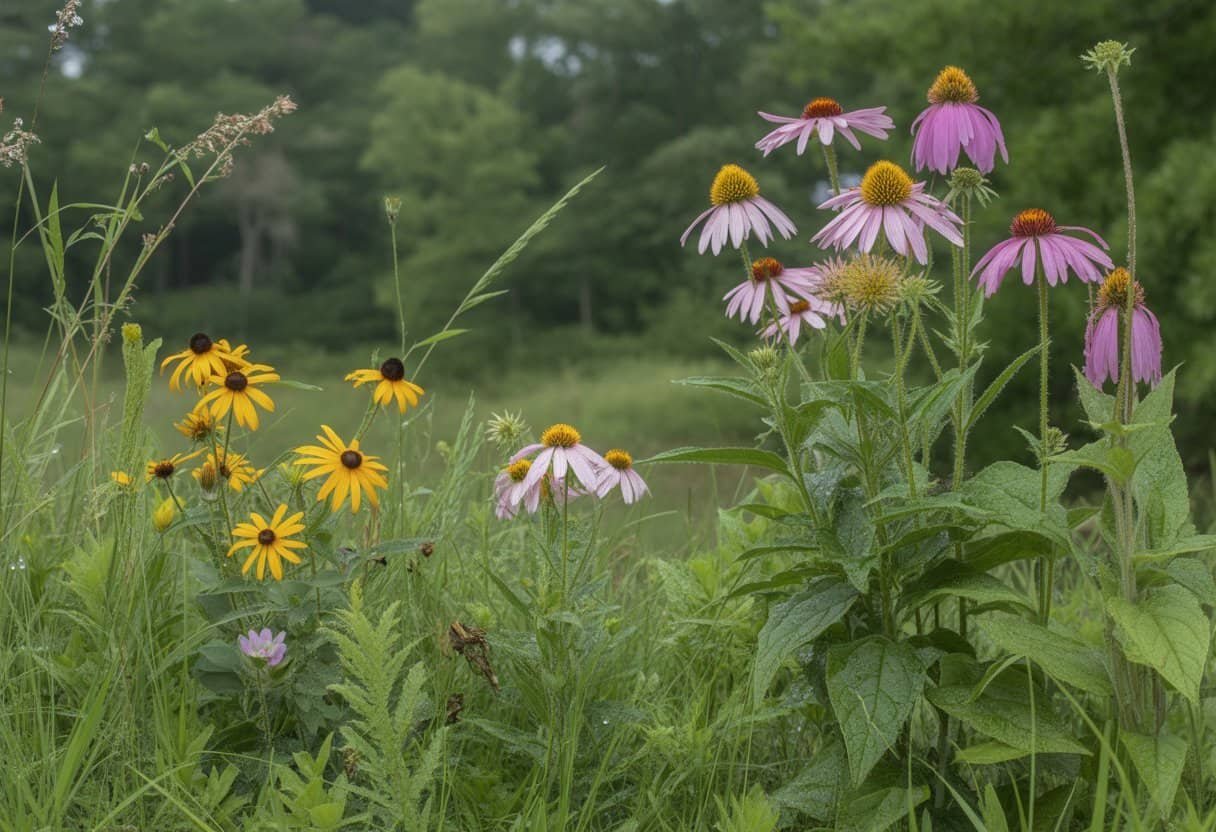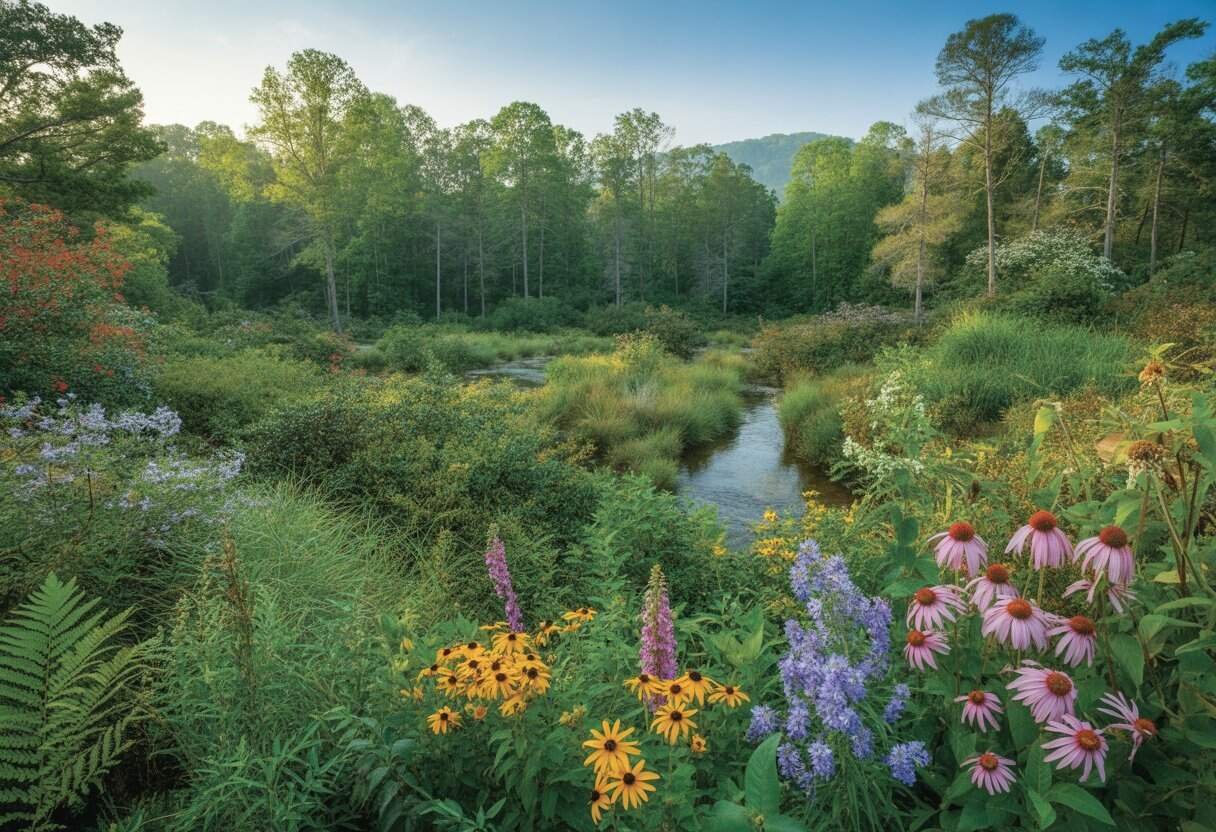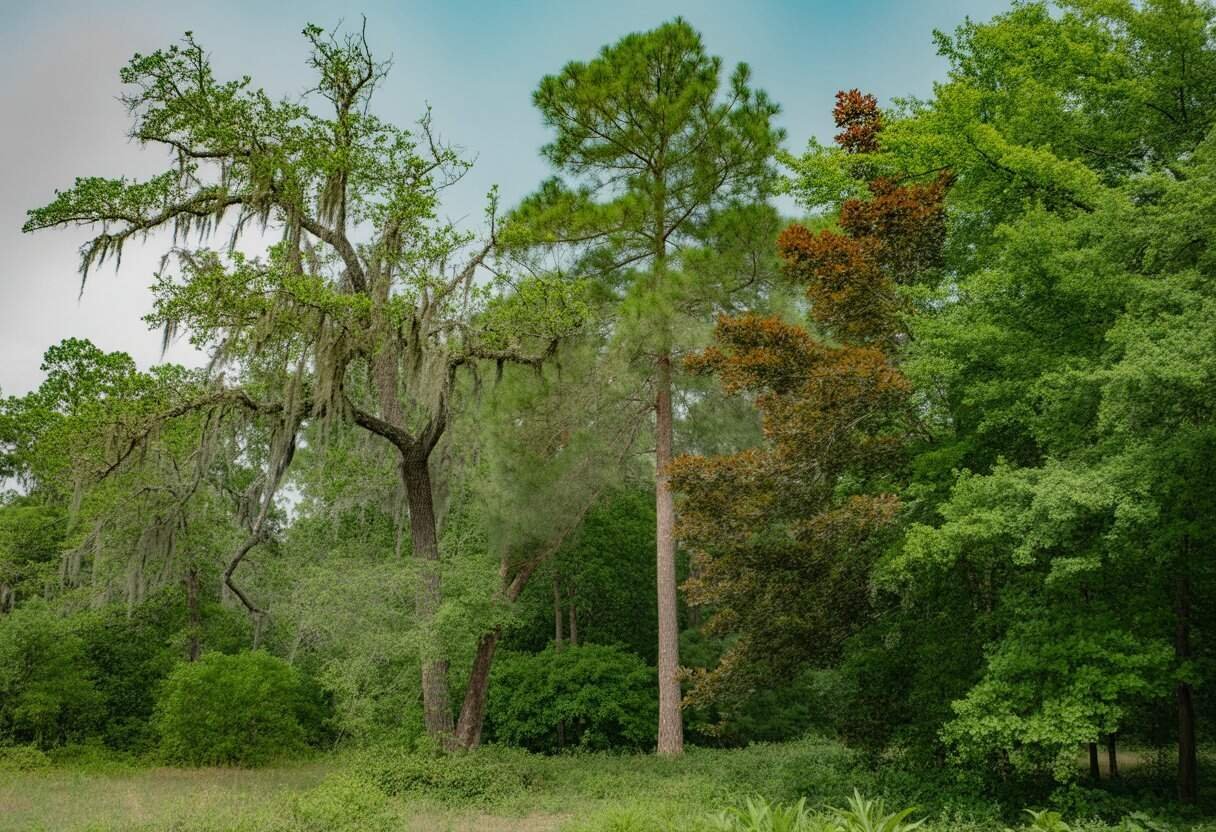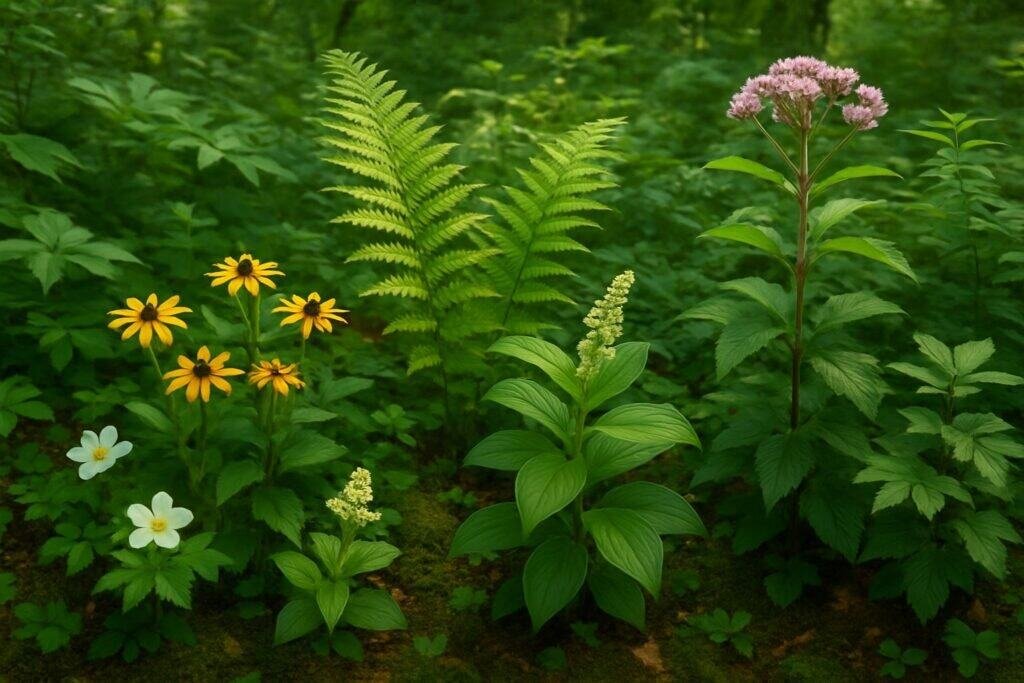Alabama is home to a rich diversity of native plants that thrive in the state’s varied landscapes. From the mountains in the north to the coastal plains in the south, these plants have adapted to local soils and climate conditions over thousands of years.
Using Alabama native plants in your garden supports local ecosystems while creating beautiful, low-maintenance landscapes that naturally resist pests and diseases.

Native plants form the backbone of Alabama’s natural heritage. They provide essential habitat for wildlife and contribute to the state’s unique ecological character.
Many of these plants offer stunning seasonal displays. You can enjoy vibrant spring blooms from azaleas and dramatic fall colors from sweetgum and maple trees.
They range from towering longleaf pines to delicate wildflowers that carpet forest floors.
Key Takeaways
- Native plants require less water, fertilizer, and maintenance than non-native species once established.
- Alabama’s diverse ecosystems support over 4,000 plant species that provide critical habitat for local wildlife.
- Incorporating native plants in home gardens helps preserve biodiversity and creates sustainable landscapes.
Overview of Alabama Native Plants
Alabama’s landscape hosts a rich variety of native plants. These plants support local wildlife, prevent erosion, and help maintain the state’s natural heritage.
Defining Alabama Native Plants
Native plants are species that occur naturally in Alabama and have evolved in the region over long periods. They existed in Alabama before European settlement and adapted to local conditions without human help.
Alabama’s native flora includes over 4,000 plant species. These range from large trees like the Southern Magnolia and Longleaf Pine to wildflowers such as the Alabama Coneflower and Cahaba Lily.
Native plants form the foundation of Alabama’s ecological communities. They develop complex relationships with local wildlife, providing food and shelter for birds, insects, and other animals.
Unlike non-native species, these plants often need less maintenance once established. They usually need less water, fertilizer, and pest control because they’re adapted to local conditions.
Biodiversity and Local Ecosystem
Alabama ranks fifth in the nation for plant diversity even though it is only 30th in size. This high biodiversity comes from the state’s varied geography, from mountains to coastal plains.
Native plants support local food webs by providing habitat and nutrition for wildlife. For example, oak trees can host over 500 species of caterpillars, which feed birds and other animals.
The state’s ecosystems depend on native plants to function properly. These plants help filter water in wetlands and prevent soil erosion along waterways.
They provide nectar for pollinators and help sequester carbon to reduce climate change impacts.
Native plant communities create specialized habitats like longleaf pine savannas. These ecosystems support rare species found nowhere else on Earth.
Regional Adaptations
Alabama’s native plants show remarkable adaptations to different regions within the state. In the north, plants develop cold hardiness for mountain winters, while coastal species tolerate salt spray and sandy soils.
Many Alabama natives have drought-tolerant features. Plants like Yaupon Holly and Eastern Redbud can thrive during dry periods because of specialized root systems and leaf structures.
Fire adaptations are common in many Alabama natives. Species like Longleaf Pine have thick bark for fire protection, and some wildflowers need periodic burns to germinate.
Native plants also develop defenses against local pests and diseases. These natural immunities reduce the need for chemicals in home landscapes.
Soil adaptations vary widely across Alabama. Plants in the Black Belt adapt to alkaline, clay-rich soils, while those in the Piedmont thrive in acidic, well-drained conditions.
Key Plant Communities in Alabama

Alabama’s diverse landscapes support several distinct plant communities. Geography, soil types, and climate shape these ecosystems.
Coastal Plain Ecosystems
The Coastal Plain covers over two-thirds of Alabama. It features unique plant communities adapted to sandy soils and seasonal flooding.
These ecosystems include bottomland hardwood forests, pitcher plant bogs, and maritime forests.
Bottomland hardwoods thrive along river floodplains. Water-tolerant species like bald cypress, tupelo, and swamp chestnut oak dominate these forests.
These forests serve as important wildlife corridors and help filter water.
Pitcher plant bogs are specialized communities in the Coastal Plain. These acidic wetlands support carnivorous plants like sundews, butterworts, and several pitcher plant species.
Maritime forests grow along barrier islands and coastal areas. Salt-tolerant species like live oak, yaupon holly, and wax myrtle thrive here.
These plants withstand hurricane-force winds, salt spray, and shifting sands.
Longleaf Pine Habitats
Longleaf pine ecosystems once covered 90 million acres across the Southeast, with Alabama containing large stands. Today, only about 3% of original longleaf forests remain.
These habitats feature an open canopy of longleaf pines with diverse understory plants. The sparse tree coverage lets sunlight reach the ground, supporting over 40 species of grasses and hundreds of wildflowers.
Longleaf forests depend on regular fire for maintenance. Without periodic burns, hardwoods and shrubs crowd out the diverse groundcover plants.
Notable understory species include wiregrass, blazing stars, and the endangered Alabama canebrake pitcher plant. These habitats support rare wildlife like the gopher tortoise and red-cockaded woodpecker.
Unique Plant Communities of the Southeastern United States
Alabama’s Appalachian highlands contain plant communities not found elsewhere in the state. Mixed mesophytic forests in these regions offer remarkable tree diversity, with over 30 species per acre.
Rock outcrops support specialized plant communities adapted to harsh conditions. Little Mountain and Smiths Lake sandstone glades feature dwarf pine forests and rare plants like the Alabama gladecress.
Limestone glades in northern Alabama represent another unique ecosystem. These thin-soiled areas support rare plants like Tennessee yellow-eyed grass and Pyne’s ground plum.
Canebrakes, dense stands of native river cane, once formed extensive thickets along Alabama’s waterways. These bamboo relatives provide important wildlife habitat and help control erosion along streams and rivers.
Common and Iconic Native Trees

Alabama’s landscape features several magnificent native trees that highlight the state’s natural heritage. These trees offer habitat for wildlife and add beauty to both urban and rural areas.
Red Maple
Red maple (Acer rubrum) is one of Alabama’s most adaptable native trees. It grows in various conditions across the state.
It reaches heights of 40-60 feet with a similar spread when mature. The tree earns its name from its brilliant red fall foliage and also features red flowers, seeds, and sometimes twigs.
In early spring, the red maple produces small clusters of red flowers before leaves appear. Red maples grow naturally in wetlands but can adapt to drier sites.
They provide valuable food for wildlife, with squirrels and chipmunks eating the seeds and deer browsing young shoots. Many homeowners choose red maples for their moderate growth rate and stunning seasonal displays.
Southern Magnolia
Southern magnolia (Magnolia grandiflora) stands as an iconic symbol of the South. It has glossy evergreen leaves and fragrant white blossoms.
This majestic tree reaches heights of 60-80 feet with a spread of 30-50 feet. The large, creamy-white flowers measure 8-12 inches across and emit a sweet lemony scent from late spring through summer.
The leathery, dark green leaves have rusty-brown undersides and remain on the tree year-round. Southern magnolias thrive in moist, well-drained soils but tolerate the clay soils common in Alabama.
Their dense canopy provides excellent nesting sites for birds, and their seeds attract various wildlife. The tree serves as both an ornamental showpiece and a valuable ecosystem supporter.
Flowering Dogwood
Flowering dogwood (Cornus florida) brightens Alabama’s woodlands with spectacular spring displays. This understory tree typically grows 15-30 feet tall with a horizontal branching pattern.
What many people call “flowers” are actually white or pink bracts surrounding the tiny yellow flowers in the center. These displays appear in early spring before the leaves emerge.
In fall, the tree produces bright red berries that attract birds and small mammals. Dogwoods prefer partial shade and moist, acidic soil.
They grow naturally along forest edges and under taller trees. The wood is extremely hard and was used for tool handles and golf club heads.
Native Americans used dogwood bark for medicinal purposes. Today, the flowering dogwood remains one of Alabama’s most beloved native trees.
Native Shrubs and Understory Plants
Alabama’s woodland understory features diverse native shrubs that offer beauty, wildlife habitat, and ecological benefits. These plants thrive in Alabama’s climate and support local ecosystems.
Oakleaf Hydrangea
Oakleaf hydrangea (Hydrangea quercifolia) is Alabama’s state wildflower. This shrub grows 6-8 feet tall and features large, oak-shaped leaves that turn burgundy in fall.
The plant produces white flower clusters up to 12 inches long in late spring. These blooms gradually turn pink to rusty-brown as they age.
Oakleaf hydrangea thrives in partial shade to dappled sunlight and well-drained, acidic soil. It grows well on woodland edges and slopes.
This native shrub requires little maintenance once established. Its peeling cinnamon-colored bark adds winter interest.
American Beautyberry
American beautyberry (Callicarpa americana) stands out for its vibrant purple berries that cluster around stems in fall. This deciduous shrub grows 3-5 feet tall with an arching habit.
The plant produces small, pale pink flowers in summer that attract pollinators. Its bright green leaves turn yellow in autumn before dropping.
Beautyberry benefits Alabama gardens by providing food for over 40 bird species. It adapts to various soil conditions and resists most pests and diseases.
Traditional folk medicine used beautyberry leaves to repel mosquitoes. Modern research confirms these leaves contain compounds that deter insects.
Southern Wax Myrtle
Southern wax myrtle (Morella cerifera) serves as a native evergreen shrub for Alabama landscapes. This plant can grow 10-15 feet tall and features aromatic, olive-green leaves.
Female plants produce waxy, blue-gray berries that persist through winter. These berries provide food for yellow-rumped warblers and other birds.
Wax myrtle tolerates poor, sandy soils, occasional flooding, and salt spray in coastal areas.
Early settlers used the berries’ waxy coating to make bayberry candles. The plant’s roots form relationships with nitrogen-fixing bacteria, improving soil quality naturally.
Colorful Native Flowers
Alabama’s landscape bursts with vibrant native flowers that add color throughout the seasons. These flowers enhance gardens and provide essential habitat for local wildlife.
Climbing Aster
Climbing Aster (Ampelaster carolinianus) stands out among Alabama’s native flowers with its striking pink to lavender blooms. This versatile plant can reach heights of 6-12 feet and uses nearby structures for support.
Flowering occurs in late summer through fall. The star-shaped flowers attract many pollinators, especially butterflies and bees.
This species thrives in moist soils and partial shade. It works well for woodland garden edges and along streams or areas with periodic flooding.
Gardeners appreciate its low maintenance needs and resistance to deer browsing. Plant Climbing Aster near a trellis or fence to showcase its climbing habit.
American Bluehearts
American Bluehearts (Buchnera americana) display deep blue to purple flowers on slender stems. This native perennial grows 1-2 feet tall in open meadows and prairies.
The tubular flowers bloom from May through September. Hummingbirds and native bees frequently visit these nectar-rich blooms.
This plant forms connections with roots of nearby grasses. Despite this semi-parasitic nature, it doesn’t harm its host plants.
American Bluehearts prefer full sun and moderate moisture. Their drought tolerance makes them suitable for low-maintenance landscapes once established.
Red Buckeye
Red Buckeye (Aesculus pavia) offers crimson-red flower clusters in early spring. This large shrub or small tree reaches 10-15 feet tall with a similar spread.
The tubular flowers grow in 4-8 inch panicles and provide an early nectar source for hummingbirds. Ruby-throated hummingbirds show particular attraction to these blooms.
After flowering, the plant produces distinctive buckeye fruits with shiny brown seeds. Warning: These seeds are toxic if ingested but pose little risk to wildlife.
Red Buckeye thrives in part shade and moist, well-drained soil. It develops best fall color when planted where it receives morning sun and afternoon shade.
This native works well as a specimen plant or as part of a mixed shrub border.
Supporting Pollinators and Wildlife
Alabama’s native plants form the backbone of local ecosystems. These plants provide essential resources for diverse wildlife species.
Native plants have evolved alongside local fauna. Their relationships benefit both plants and animals.
Role of Native Plants in Pollinator Health
Native Alabama plants support pollinators throughout their life cycles. Species like Eastern Purple Coneflower, Black-eyed Susan, and Alabama Croton produce nectar and pollen that match the needs of native bees, butterflies, and moths.
Key Alabama Pollinators:
- Carolina sphinx moth
- Eastern tiger swallowtail
- Rusty patched bumblebee
- Eastern blueberry bee
Many Alabama pollinators rely on specific native plants. For example, milkweed species are essential for monarch butterfly reproduction and serve as the only food source for their larvae.
Native flowering plants bloom in succession throughout the growing season. This provides consistent food sources when non-native ornamentals aren’t flowering.
Habitat Creation for Local Fauna
Alabama native plants create layered habitats that support diverse wildlife beyond pollinators. Shrubs like American Beautyberry provide nesting sites and protection from predators.
Native trees such as Southern Magnolia and White Oak produce nuts, seeds, and fruits that feed squirrels, birds, and other wildlife. Their leaf litter creates habitat for beneficial insects and decomposers.
Wildlife Supported by Native Plants:
| Plant Type | Wildlife Benefits |
|---|---|
| Trees | Nesting sites, food, shelter |
| Shrubs | Cover, berries, habitat |
| Grasses | Seeds, nesting material |
Native grasses like Little Bluestem provide winter shelter for insects and small mammals. Their root systems support soil health and water filtration.
Conservation and Sustainable Gardening
Growing native Alabama plants protects local ecosystems and creates beautiful, low-maintenance gardens. Native plants support wildlife and require fewer resources than non-native alternatives.
Benefits of Growing Native Species
Native Alabama plants adapt to local soil and climate conditions. They typically need less water once established, reducing the need for irrigation and conserving water.
These plants have natural defenses against local pests and diseases. This reduces or eliminates the need for chemical pesticides and fertilizers.
Native plants provide habitat and food for local wildlife. Butterflies, bees, birds, and other pollinators depend on these plants for survival.
By growing natives, gardeners help maintain biodiversity and support functioning ecosystems. Using native plants also helps preserve Alabama’s natural heritage.
Many native species are becoming less common as development changes the landscape.
Integrating Native Plants into Gardens
Add native plants to existing gardens gradually. Replace non-natives with similar native alternatives when needed.
For example, substitute native azaleas for imported varieties. Create designated native plant areas within larger landscapes.
These “pocket habitats” support wildlife while maintaining the garden design. Choose plants suited to your specific conditions.
Alabama’s diverse regions support different native plant communities. Consider sun exposure, soil type, and moisture levels.
Group plants with similar water needs together. This practice, called hydrozoning, helps conserve water and ensures plants thrive.
Native plant nurseries offer expertise and appropriate selections for your area. These specialists can recommend plants that will succeed in your specific garden conditions.
Frequently Asked Questions
Alabama’s native plants offer many benefits for home landscapes and natural areas. These plants have adapted to local conditions over thousands of years and support local wildlife.
What are some indigenous plants suitable for landscaping in Alabama?
Alabama offers many native plants perfect for home landscapes. Eastern redbud trees provide spring blooms while oakleaf hydrangea offers summer flowers and fall color.
Black-eyed Susans and purple coneflowers thrive in sunny spots and require minimal maintenance. Native azaleas add vibrant spring color in partial shade areas.
For ground cover, try green-and-gold or creeping phlox. These spread nicely and offer seasonal blooms while preventing erosion and reducing weeds.
How can one identify native plants in Alabama?
Plant identification apps like iNaturalist or PlantNet help identify unknown species through photos. Field guides specific to Alabama or the Southeast provide detailed information on native plants.
Leaf shape, flower structure, and growth pattern offer important clues. The Alabama Plant Atlas website maintains a comprehensive database of native species with photos and descriptions.
Joining local native plant societies connects beginners with experienced botanists. They share identification tips during field trips and workshops.
Where can I purchase native plants in Alabama?
Native plant nurseries operate throughout Alabama, with notable locations in Birmingham, Huntsville, and Mobile. These nurseries focus exclusively on plants indigenous to the region.
Many botanical gardens host annual native plant sales and offer expert advice. The Huntsville Botanical Garden and Birmingham Botanical Gardens hold popular spring and fall sales.
Online nurseries like Plant Native and Prairie Moon ship Alabama-native species throughout the state. Local conservation groups sometimes organize community plant swaps or sales.
Which flowers are commonly found in Alabama and are native to the region?
Butterflyweed displays bright orange flowers that attract monarch butterflies from June through August. Alabama’s state wildflower, the oak-leaf hydrangea, produces white blooms that turn pink-purple as they age.
Cardinal flower produces striking red blooms in late summer and thrives in moist areas. Joe-Pye weed reaches impressive heights with dusty pink flower clusters that butterflies love.
Wild columbine shows unique red and yellow nodding flowers in spring. Blazing star sends up purple spikes in late summer that attract many pollinators.
What trees and shrubs are native to Alabama?
Longleaf pine once dominated Alabama’s landscape and supports diverse wildlife. Southern magnolia offers glossy evergreen leaves and large fragrant white flowers throughout summer.
American beautyberry produces striking purple berries in fall that birds eagerly consume. Eastern redcedar provides year-round evergreen structure and blue berries for wildlife.
Serviceberry blooms early with white flowers followed by edible berries. Red maple offers brilliant fall color while sweetbay magnolia thrives in wet areas with fragrant flowers.
What are the best Alabama-native plants for attracting hummingbirds?
Trumpet honeysuckle vines grow tubular red flowers that fit hummingbird beaks.
Cardinal flower has brilliant red blooms that attract these tiny birds in late summer.
Eastern columbine offers unique red and yellow flowers that bring in early-season hummingbirds during spring.
Native azaleas, especially the flame azalea, have funnel-shaped flowers rich in nectar.
Bee balm produces spiky red or purple blooms that hummingbirds love.
Plant these species in groups near windows or patios to enjoy frequent visits from hummingbirds.


